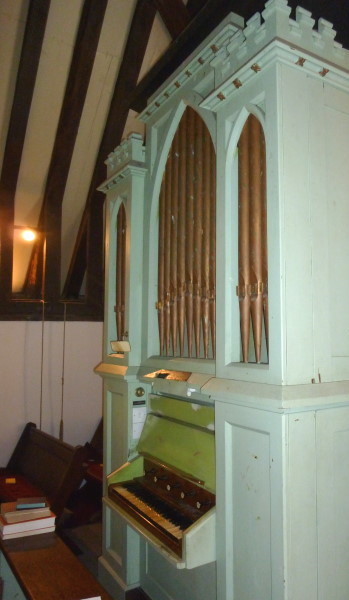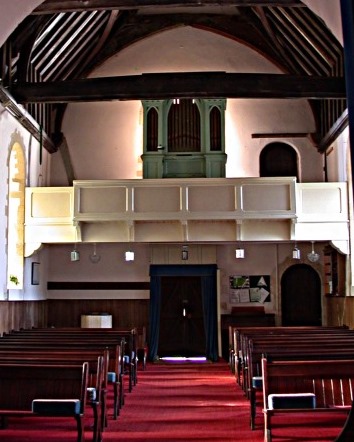St Nicholas Newnham
 This note has been compiled in May 2014 from information supplied by the Royal College of Organists library; the National Pipe Organ Register, and the British Organ Archive maintained by the Cadbury Research Library at the University of Birmingham; and from a document held in the safe of St Nicholas Newnham that was written in December 1951 by Herbert Norman, who read the lesson at the Service of Dedication in January 1952 and was a descendent of one of the founders of the organ building company. To view the St Nicholas Newnham page on the National Pipe Organ Register please click here.
This note has been compiled in May 2014 from information supplied by the Royal College of Organists library; the National Pipe Organ Register, and the British Organ Archive maintained by the Cadbury Research Library at the University of Birmingham; and from a document held in the safe of St Nicholas Newnham that was written in December 1951 by Herbert Norman, who read the lesson at the Service of Dedication in January 1952 and was a descendent of one of the founders of the organ building company. To view the St Nicholas Newnham page on the National Pipe Organ Register please click here.
The organ was presented to St Nicholas Church Newnham at a Service of Dedication on Sunday 13th January 1952 by Mrs F. E. W. Bell of Newnham Green Farm. It was built by the renowned organ makers Hill, Norman & Beard.
William Hill (1789-1870) was one of the main English organ builders of the 19th century. He married the daughter of the organ builder Thomas Elliot, and worked for him until Elliot’s death in 1832 when Hill inherited the firm and was joined in the business by his elder son (also William). In 1855, Hill’s younger son Thomas also entered the business, and he eventually took over the management of Hill & Son after his father’s death in 1870. Hill & Son built organs of the highest quality, including many Cathedral organs. The firm continued under Dr Arthur George Hill, nephew of Thomas, until in 1916, having no male heirs to sustain the business, he amalgamated it with another major company “Norman & Beard”.
The firm Norman & Beard originated from a business founded in 1870 by Ernest William Norman. In 1876 he went into partnership with his brother, Herbert John Norman, and in 1887 they in turn entered into partnership with George A Wales Beard, before amalgamating with William Hill & Sons in 1916 to create the huge organ building concern “Hill & Son and Norman & Beard Ltd”, later known just as “Hill, Norman & Beard”.
In 1923, Hill, Norman & Beard was acquired by John Christie, the owner of Glyndebourne and founder of Glyndebourne Opera. The next year, 1924, Christie also acquired the organ firm “Forster and Andrews” and merged it with Hill, Norman & Beard. Forster & Andrews had been formed in Hull in 1843 by James Alderson Forster and Joseph King Andrews.
The combined business looked after many of the country’s large Cathedral organs, but additionally was constantly updating its approach to organ building, so that it also played a major role in the Theatre and Cinema organ business of the 1920s and 1930s. However, by the later part of the 20th century a number of long-established organ companies were finding their businesses harder to sustain, as many fewer organs were being built compared with the vast output of the late 19th century when the majority of English churches were installing new or replacement instruments. Hill, Norman & Beard closed in 1998.
The Newnham organ was reconstructed in 1951 from an old Forster & Andrews instrument that had been installed elsewhere in the country nearly 100 years earlier – some time in the 1850s. A note in the church safe, written by Herbert Norman, a descendent of one of the founders of Hill, Norman & Beard, includes “The Organ in Newnham Church … was made … from the choicest material that came into the great port of Hull. White Pine from Russia, Spruce from Norway, Swedish Birch, Austrian Oak, and fine Mahogany from Central America. English Lead and Cornish Tin are in its pipes. Elephant Tusk Ivory is on its keys. Despite its neat dimensions, there are 268 organ pipes in it, some of wood, but mostly of metal, each of different shape, length and thickness. The largest is 10 feet long and almost 20 inches in girth, while the tiniest is not as long as a new pencil and less than half as thick. These are arranged in 5 ranks, each giving a different musical sound, but each blending with any or all of the others.”
The following is an extract from a 1952 “Organ Club” periodical, written soon after the Service of Dedication:
 Newnham, Hook, Hants
Newnham, Hook, Hants
This village is some forty miles from London, half a mile north of the junction of the road from Odiham with highway A30. In the tiny Norman church Messrs. Hill, Norman & Beard have just installed, in the West gallery, a very charming and simple little organ which has been completely reconstructed from an old Forster & Andrews organ which came from another church. There are five stops, all unenclosed, Open Diapason 8, Stopped Diapason 8, Bell Gamba 8 (grooved bass to S.D.), Gemshorn 4 and Flageolct 2. All the stops are of almost equal power and blend perfectly in any combination. The wind pressure is 2½", electric blower, the action is tracker, there are two composition pedals and no pedal board.
The original Gothic case has been re-made and greatly improved, while still retaining its Gothic flavour. The wooden front ‘pipes’, with their original leaf gold, are now beautifully set off by the woodwork of the case, which is now a subtle, almost pastel shade of green.
At the Service of Dedication on January 13th, 1952, Dr. Henry Havergal, Master of Music at Winchester College, played a short recital which included the works of Bach, Brahms and Handel, there was a special choir and Mr. Herbert Norman read the lesson.